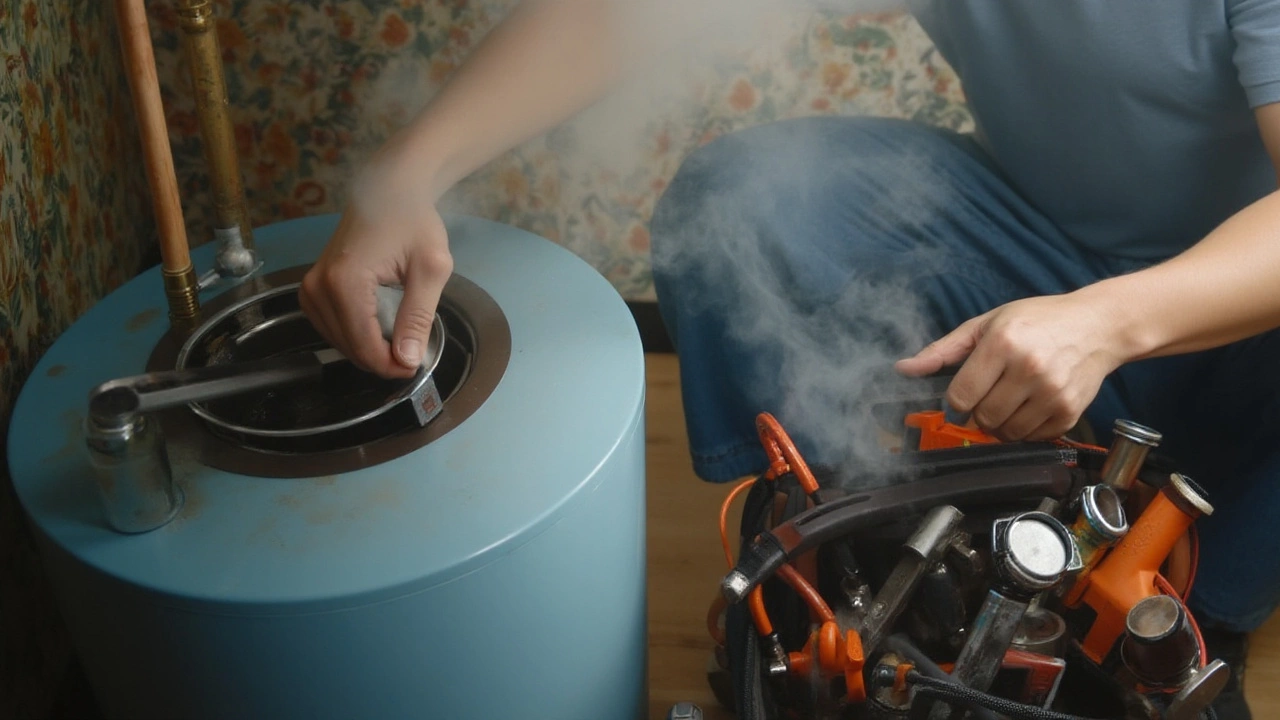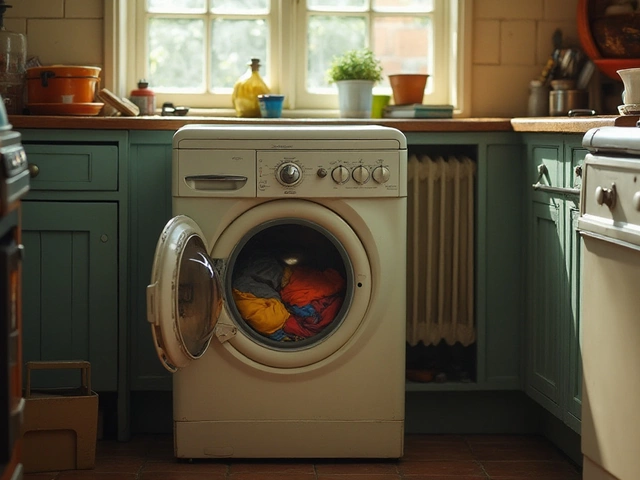Water heaters may not be the most exciting piece of equipment in your home, but taking care of them is crucial for enjoying that hot morning shower or achieving spotless dishes. One common question homeowners face is whether to flush or drain their water heaters. While both are maintenance options, each comes with its own set of advantages and potential pitfalls.
Understanding why and when to perform these tasks can make a significant difference in the efficiency and longevity of your water heater. In this exploration, we'll unravel what each method involves, why it's important, and how you can decide the best course of action for your household needs. Armed with this knowledge, you can ensure hot water continues to flow smoothly through your pipes without interruption.
- Understanding Water Heater Maintenance
- What is Flushing?
- What is Draining?
- Benefits of Flushing and Draining
- Potential Risks and Considerations
- Tips for Regular Water Heater Care
Understanding Water Heater Maintenance
Every home, whether large or small, leans heavily on the reliable workhorse tucked away in the basement or utility closet – the water heater. This unsung hero quietly ensures that our showers stay steamy, our cleaning tasks more efficient, and our homes comfortably warm. However, like any mechanical system, a water heater requires regular attention to continue functioning well. Proper water heater maintenance isn't just about preventing a cold surprise one day; it's about conserving energy and saving money over time. By staying on top of maintenance tasks, homeowners can extend the lifespan of their unit, ensuring optimal performance and efficiency.
Water heaters come in various types, each with its own principles of operation. From traditional tank models to tankless systems, regardless of the configuration, sediment build-up from hard water is a universal issue. Over time, minerals from your water supply settle at the bottom of traditional water heaters. If left unchecked, this sediment can insulate the water from the heating element, causing inefficiency and increased heating costs. It can also lead to strange noises as pockets of steam push through the layer of hardened minerals. A routine maintenance habit can prevent these deposits from crystallizing, reducing wear and tear on the system.
Maintaining a water heater involves tasks like checking the pressure relief valve, setting the thermostat at an optimal temperature, and inspecting the anode rod for corrosion. Flushing and draining are also highlighted maintenance activities. While these terms are often used interchangeably, they represent different scopes of action. Despite the task being seemingly straightforward, it's surprising how effective and important these simple actions are. The U.S. Department of Energy states that sediment build-up can reduce the efficiency of your unit by 30% or more, highlighting the importance of regular upkeep.
For many, the idea of tinkering with a water heater might sound daunting, but it's more manageable than it seems. Still, enlisting a professional can lend a sense of assurance, especially if the appliance hasn't been serviced in years. According to a comprehensive survey by EnergyStar, well-maintained water heaters can run two years longer than neglected ones. This not only protects the equipment investment but also ensures uninterrupted service and energy savings. With energy efficiency being more important than ever, it's clear that prioritizing the maintenance of your water heater is integral to both household convenience and sustainability.
"An efficiently operating water heater can significantly reduce the second-largest household utility expense," advises the Energy Efficiency & Renewable Energy department.This simple acknowledgment underscores how impactful understanding and practicing regular water heater maintenance can be. It underscores the essence of maintenance beyond mere equipment longevity, pointing towards a broader environmental responsibility. Each small step, from the semi-annual check-up to the annual flush, contributes to the well-being of the home and the planet.
What is Flushing?
Flushing a water heater is an essential part of maintaining your system, but what does it actually entail? At its core, flushing involves clearing out sediments and mineral build-up from the tank. Over time, as water continuously flows into your heater, minerals like calcium and magnesium naturally settle at the bottom. This sediment can harden, reducing the efficiency of your heater and can even damage it.
Flushing is done by first turning off the power or gas supply, to ensure safe handling during the process. Next, a hose is attached to the drain valve, typically located at the bottom of the tank. Water is then allowed to flow out, taking with it the unwanted sediments. This procedure brings several advantages: improved efficiency of your water heater, reduced energy consumption, and prolonged appliance lifespan.
Regular flushing also prevents strange noises from your heater. You've probably heard odd rumblings coming from your appliance at odd hours. Often, these sounds are due to water boiling beneath a layer of sediment. A clean tank not only sounds quieter but heats water more evenly. A study in the Journal of Energy Storage found that heaters with routine sediment removal operations could see an up to 15% increase in efficiency.
"Regular maintenance like flushing your water heater is a crucial step in ensuring its longevity and conserving energy," says Jane Davis, a noted expert in residential energy solutions.
When Should You Flush?
Now, addressing the timing aspect: how often is frequent enough for flushing your heater? While it varies based on the water quality in your area, a general rule of thumb is to flush out your heater once a year. If you live in an area with particularly hard water, it might be necessary to perform this task twice annually. The effort will ensure your water heater maintenance keeps your system in top-notch condition.
For those who relish a bit of technical detail, a quick chemistry lesson: the minerals that cause sediment build-up are often invisible enemies. Known as "hard water" deposits, these culprits make a heater less efficient over time. By flushing, you lower the risk of these unsolicited tenants taking root and causing havoc inside your tank. While DIY kits abound, it's often wise to rely on professionals, especially if it’s your first time flushing a heater. No one wants to face an unexpected watery disaster!

What is Draining?
Draining your water heater is akin to giving it a detox. By clearing out the sedimentary build-up that naturally accumulates over time, you help maintain its performance and efficiency. This build-up is often comprised of minerals like calcium and magnesium, which precipitate out of hard water. Left unchecked, sediment can lead to clogs, reduced heating efficiency, and even damage your heating element. Regular draining ensures your water heater doesn't work overtime, saving on energy bills and prolonging its life.
To drain a water heater, a systematic approach is advisable. First, ensure safety by turning off the power supply to the heater if it's electric, or setting the gas valve to the 'pilot' position for gas heaters. Allow the water to cool to avoid burns. Then, connect a garden hose to the drain valve, running the other end into a suitable drainage point. Open the valve and allow gravity to do the work, letting the water and sediment flow out. This process is typically straightforward but can require time and patience, especially when dealing with extensive build-up.
Draining is not without its considerations; for instance, frequent draining might not be necessary for all water heaters, especially those in areas with soft water. Over-draining can sometimes be counterproductive, putting undue stress on the heater's components. Moreover, the process can introduce air into the system, potentially leading to issues like noisy pipes or air locks. It's a balance of frequency and necessity, often influenced by the hardness of your local water supply. Over time, you will develop an intuition for when your heater feels overdue for maintenance.
"Neglecting routine maintenance can chop a water heater's lifespan in half," warns the American Society of Home Inspectors. This organization emphasizes that one benefits greatly when regular upkeep avoids costly repairs or premature replacements.
In terms of regularity, the rule of thumb is to drain once a year. However, households with particularly hard water might opt to do so more often, potentially every six months. Keep an eye out for telltale signs that your water heater needs attention, such as unusual noises or inexplicably high energy bills. Sometimes, a simple drain can restore things to normal. Always remember, though, when in doubt, get a professional to take a look, ensuring every step conducted aligns with your manufacturer's guidelines.
| Action | Frequency | Benefit |
|---|---|---|
| Drain Water Heater | Every 6-12 months | Improves efficiency |
| Check Sediment Build-up | Annually | Prevents clogs |
| Inspect for Leaks | Quarterly | Avoids water damage |
Benefits of Flushing and Draining
Regular maintenance of your water heater is essential to keep it running efficiently and extending its lifespan. Whether you decide to flush water heater or drain it completely, both methods hold distinct advantages. Let's delve into why these practices are recommended by many experts and how they can play a pivotal role in maintaining your home's hot water supply.
Flushing your water heater involves removing sediment that builds up over time. These mineral deposits can settle at the bottom of the tank and have various effects. They can create an insulating layer, which forces the heater to work harder and consume more energy. Regular flushing helps to clear this layer, increasing energy efficiency and lowering utility bills. It’s akin to regularly cleaning a car’s engine to ensure it doesn’t guzzle gas. This process can also minimize wear and tear on the appliance, protecting vital components from damage caused by overheating.
Draining, on the other hand, involves emptying the tank completely to not only flush out debris but also inspect for other potential issues. It’s particularly useful when you suspect corrosion, as a thorough drainage allows you to examine the tank’s interior visually or detect any unusual residue more effectively. Draining regularly can prevent the buildup of harmful bacteria and mineral deposits that might compromise the safety and quality of your hot water.
According to the U.S. Department of Energy, 'Regular maintenance of water heaters, such as flushing or draining, can extend the appliance’s life expectancy by five years or more and improve efficiency by 30%.'
While both methods are beneficial, they also come with risks if not done correctly. For instance, improper flushing might disrupt the sediment layer, scattering it throughout the tank rather than removing it. Draining the tank without refilling slowly can lead to pressure-related damage or air pockets. Therefore, consider consulting a professional to balance these tasks or ensure you're well-equipped if opting for the DIY route. Whatever route you choose, consistent attention to your water heater’s health will save you frustration in the long haul.
Let's not forget, flushing and draining are also about prevention beyond efficiency. Regular upkeep reduces the chances of expensive breakdowns and guards against emergency cold showers! These routines might seem tedious, but when planned correctly, they require minimal effort compared to the reward of a smoothly functioning water heater system.

Potential Risks and Considerations
When it comes to the maintenance of your water heater, both flushing and draining are tasks that can come with certain risks if not performed correctly. One potential risk associated with regularly flushing your water heater is the possibility of creating leaks. As the sediments are disturbed and flushed out, the pressure levels inside the tank can sometimes lead to tiny leaks, especially in older tanks or those prone to corrosion. This is a reminder that while maintenance is essential, knowing the age and condition of your equipment can prevent unexpected issues.
There's also the chance of damaging the drain valve. This component, often made from plastic, can become brittle over time due to constant exposure to heat and water. Once you begin the process of draining the water heater, a fragile valve might break or leak afterward, requiring an immediate replacement. This means that equipping yourself with knowledge about the parts of your water heater can be crucial in preventing mishaps. Knowledgeable homeowners might consider having a spare valve on hand in case such an event occurs.
Another consideration is sediment displacement. While removing sediment is beneficial, it's important to understand that the agitation of settled particles can initially result in cloudier water or slight disturbances in water quality. This is temporary and usually resolves quickly. However, those unfamiliar with the process might find it concerning. Taking things slowly, being mindful of water temperature, and starting a small flush might help mitigate these initial concerns.
For those who choose not to personally handle their water heater maintenance, hiring a professional can be an added expense. However, professional services offer peace of mind, as skilled technicians can typically identify additional potential issues during regular maintenance. "The cost of hiring a professional might seem like a lot, but catching issues early can potentially save homeowners from expensive emergency repairs down the line," notes a seasoned technician from Water Heater Savior Services. Weighing these costs against the potential benefits is something every homeowner will want to consider.
It’s also important to keep in mind that some systems might come with specific manufacturer recommendations or warranties. Ignoring these can sometimes void warranties or create issues with future claims. Checking the user manual or contacting the manufacturer before proceeding with any kind of water heater maintenance might prevent unwanted consequences.
Tips for Regular Water Heater Care
Caring for your water heater is not just about waiting for problems to arise. It's about regular attention and simple maintenance steps that can prevent unexpected breakdowns and help the water heater operate efficiently for its entire lifespan. The first tip is checking the temperature setting. Ideally, the thermostat should be set at 120 degrees Fahrenheit, balancing energy efficiency with safety to prevent scalding and prolonging the heater's life.
Another crucial step is examining the pressure relief valve, a component essential for safety. To check it, place a bucket under the pipe after turning off both the electricity and water supply. Carefully open the valve, and if water rushes out, things are functioning as they should. If not, it might be a sign the valve needs replacement. Regularly inspecting this valve can be the difference between a calm household and an emergency.
Don't underestimate the potential of sediment buildup, which is more prevalent in areas with hard water. These mineral deposits reduce your system’s efficiency and could lead to permanent damage. A great way to combat this is through flushing the water heater, which can be done annually. While flushing might be simple for some, it sometimes requires professional intervention to avoid disruption or mishaps.
"Ignoring regular maintenance of your water heater is like ignoring an oil change for your car—it might seem fine now, but it could cost you significantly down the line," advises maintenance expert Walter Smith, who has over two decades of experience in plumbing and heating systems.
Furthermore, insulating the water heater and the surrounding pipes is another savvy method to ensure efficiency and save on energy costs. Thankfully, there are pre-cut jackets and pipe insulators available that make this task achievable for most homeowners. This insulation helps minimize standby heat losses, keeping water hot for extended periods and reducing the workload on the heating elements.
If you have an older model or you’ve been neglectful thus far, take some time to examine the anode rod, which is crucial in protecting the tank from corrosion. Usually, this rod should be replaced every three to five years. Without it, your heater tank might succumb to rust prematurely, leading to expensive repairs or the need for a full replacement.
Finally, remember to keep an eye out for leaks, odors, and sounds that seem out of place, as they often indicate something deeper. Implement these regular checks as part of your routine home maintenance, and you’ll likely save on both energy bills and potentially costly repairs. Thus, keeping your water heater running efficiently for years to come.





